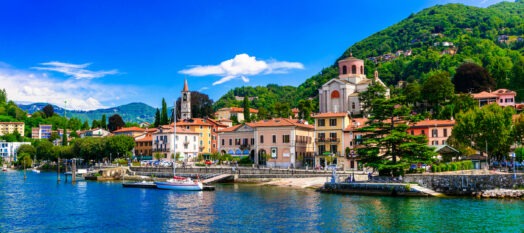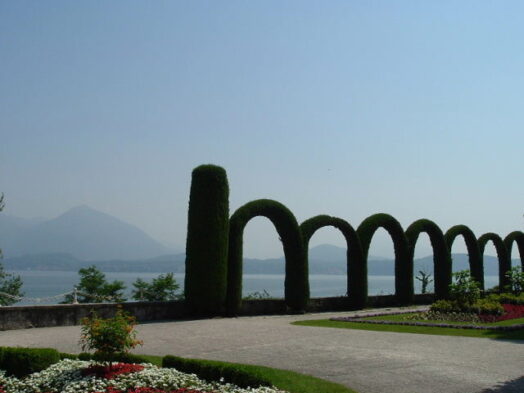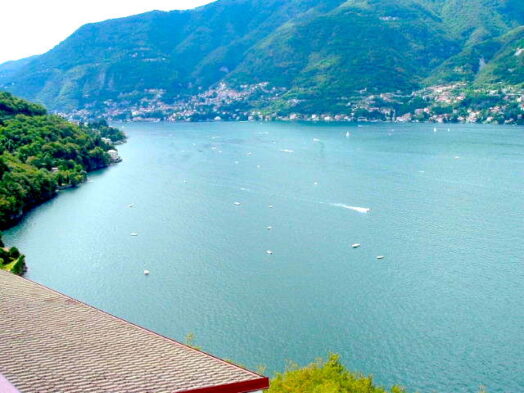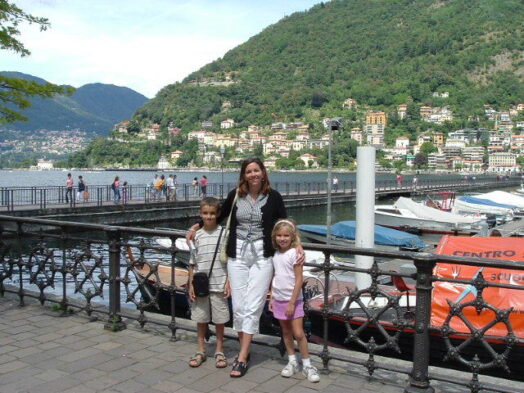Most visitors flock to Lake Como in hopes of catching a glimpse of the island’s most famous resident, George Clooney. But many are missing out on what is truly the region’s most impressive lake, Lago Maggiore (Lago is lake in Italian). I lived in Milan for several years and this was always my favorite day trip. Over the years, I’ve recommended choosing Lake Maggiore vs. Lake Como. People thank me for introducing them to this surprising destination in Italy’s lake region.
Both lakes are easy to reach from Milan by train, about an hour ride. Lake Maggiore borders Milan on the North and Switzerland on the East. This unique alpine position helps the lake maintain a warm Mediterranean climate where tropical plants bloom year-round. You’ll see palm trees, magnolias, roses and camellias. And while Lake Maggiore isn’t home to famous movie stars, it has share of world-famous visitors, namely Hemingway, Napolean, Mussolini, Rothschild and Clark Gable. Hemingway aficionados might recall that Lake Maggiore’s Borromean Islands were the setting for A Farewell to Arms.

About Italy’s Lake Region
Italy’s Lake Region, nestled in the northern part of the country, is renowned for its stunning landscapes, charming towns, and rich cultural heritage. This picturesque area is home to several lakes, including the iconic Lake Como, Lake Garda, and Lake Maggiore, each offering unique attractions and scenic beauty. Surrounded by the Alps, the lakes are framed by rolling hills, lush vineyards, and quaint villages, making the region a popular destination for outdoor enthusiasts, history buffs, and those seeking tranquility. Visitors can explore historic villas, indulge in local cuisine, and enjoy a range of activities from boating to hiking. Whether you’re relaxing by the lakeside or exploring the vibrant towns, the Lake Region of Italy provides a captivating escape.
How Lake Maggiore is Different from Lake Como
When it comes to Italy’s northern lakes, Lake Como and Lake Maggiore are two of the most famous destinations. While both lakes share stunning views of the Alps, charming lakeside towns, and a rich cultural history, they each offer a unique experience that sets them apart. Whether you’re a seasoned traveler or planning your first visit, understanding the differences between these two lakes can help you decide which one is right for your next Italian getaway.
Surrounded by mountains and a rigid coastline, Lake Maggiore has a completely different vibe than the more popular (dare I say more touristy) Lake Como. The road surrounding the lake is at water level in contrast to Lake Como’s which takes you high along the mountains’ ridge. In essence, you’re looking down on one lake and out at another. Lake Maggiore is my . When anyone asks me what to do in Lake Como, I say, “Go to Lake Maggiore!”
1. Size and Location
Lake Como is the third-largest lake in Italy, covering an area of about 146 square kilometers. It has a distinctive shape, resembling an inverted “Y” with three branches that meet at its central point. This gives the lake a series of small, picturesque towns dotting its shoreline. Lake Como is located in the Lombardy region of northern Italy, close to the Swiss border, making it easily accessible from Milan.
On the other hand, Lake Maggiore is larger, covering around 212 square kilometers. Situated along the border between Italy and Switzerland, it is the second-largest lake in Italy. The lake stretches across two countries, with its shores belonging to the Italian regions of Piedmont and Lombardy, and the Swiss canton of Ticino. The broader expanse of Lake Maggiore means its shoreline is home to a greater variety of landscapes, from mountainous terrain to lush gardens and vineyards.
2. The Towns and Villages
Lake Como is famous for its exclusive and glamorous towns like Bellagio, Varenna, and Menaggio. These towns are known for their upscale hotels, elegant villas, and stunning gardens, attracting celebrities and high-profile visitors from around the world. Lake Como also boasts an aristocratic atmosphere, with its historic villas—many of which are still privately owned—making it the ideal destination for those seeking a luxurious retreat.
Lake Maggiore, however, offers a more relaxed and laid-back atmosphere, with a wider variety of towns to explore. Stresa, one of the most popular towns on the lake’s Italian side, is a charming lakeside resort town that exudes old-world charm, complete with grand hotels and lush gardens. The town is also famous for its proximity to the Borromean Islands—Isola Bella, Isola Madre, and Isola dei Pescatori—which are home to magnificent palaces and botanical gardens. Lake Maggiore’s towns tend to have a more intimate, less crowded feel compared to Lake Como’s glamorous spots.
3. Nature and Activities
Both lakes are ideal for nature lovers, but their landscapes vary in character. Lake Como’s dramatic terrain, with steep mountains rising sharply from the water’s edge, creates a sense of awe and adventure. Hiking trails around the lake offer incredible views, and boat tours provide a great way to explore its secluded coves and stunning villas. The surrounding forests and mountains offer opportunities for outdoor activities like trekking and mountain biking.
In contrast, Lake Maggiore offers a more diverse range of environments, from its alpine backdrop to the lush Mediterranean vegetation around its shores. The lake’s mild climate allows for the cultivation of subtropical plants, making the gardens in towns like Verbania and the Borromean Islands particularly noteworthy. Hiking and biking are also popular here, but Lake Maggiore is renowned for its boating opportunities, with a range of islands, such as the Borromean Islands, and picturesque shoreline villages to explore.
4. Cultural Attractions
Cultural enthusiasts will find plenty to discover in both lakes. Lake Como is steeped in history, with a rich array of villas, palaces, and churches dating back to the Roman era. The famous Villa del Balbianello, featured in movies like James Bond’s Casino Royale, and the 14th-century Basilica di San Giacomo in Bellagio are just a few examples of the lake’s historical treasures.
Lake Maggiore, while similarly rich in history, offers a slightly different cultural experience. One of its key highlights is the Borromean Islands, where visitors can tour stunning palaces and gardens, such as the opulent Palazzo Borromeo on Isola Bella. The nearby town of Arona boasts the impressive Statue of Saint Charles, one of the largest statues in the world. Lake Maggiore’s proximity to Switzerland also gives it a unique blend of Italian and Swiss influences, particularly in its architecture and cuisine.
5. Atmosphere and Vibe
The overall atmosphere of the two lakes is one of their most notable differences. Lake Como has a more refined, sophisticated vibe, attracting those looking for a high-end retreat surrounded by luxury and tranquility. It’s ideal for travelers who enjoy the glamour of Italian lake life, with a focus on fine dining, high-end shopping, and exclusive villa tours.
Lake Maggiore, on the other hand, offers a more relaxed and family-friendly environment. Its picturesque towns, calm waters, and lush greenery create an inviting atmosphere perfect for those looking to unwind without the crowds. The lake also has a more diverse selection of activities, from boat trips to exploring historical sites, making it ideal for a more versatile vacation.
What to do on Lake Maggiore
The most popular town on the lake is Stresa. It’s a festive town with a winding boardwalk along the lake lined with tropical foliage and blooming perennials. Stresa’s northern end boasts several spectacular hotels with spectacular views. In summer months, Piazza Cadorna hosts local bands playing to the restaurant patrons around the Piazza. I enjoy strolling through the winding streets visiting the enotecas to sample wine, cheese and other local favorites.
Stresa is also home to Villa Pallavicino, part nature park part zoological garden, and a desirable destination for both families and botanists alike. My kids especially loved Villa Pallavicino’s beautiful gardens and a petting zoo, not to mention the gorgeous views! The park’s natural walking paths are shaded by old oak canopies and lined with the largest hydrangeas one has ever seen. The zoo is home to a bevy of exotic, and not so exotic, animals including peacocks, zebra, kangaroos, llamas and even goats that roam the range of the park.



The three Borromean Islands are named for the Borromeo family, which has owned them since the 12th century. Ferries run from each island every hour so you can easily spend an entire day island-hopping. Isola Bella and Isola Madre both house breathtaking botanical gardens and plenty of small restaurants and unique shops. Yet Isola dei Pescatori (Island of the Fishermen) is my personal favorite. Less than 100 yards wide and only about 1/4 mile long, this island has a character unlike any other with narrow pathways strung with fishing nets and the island’s adopted wild cat population which roam the island in search of fishermen’s catch.


Where to stay on Lake Maggiore
Stresa has many notable hotels including the Grand Hotel des Iles Borromées. But in my opinion, the best Lake Maggiore hotel is the family-run La Palma, the only hotel with a swimming pool (literally) on the lake. It’s quaint, comfortable, and affordable.
Don’t get me wrong. Lake Como is beautiful but IMHO there are more family-friendly activities on Lake Maggiore. So if you’re wondering, “Should I go to Lake Como or Lake Maggiore?”, my advice is the latter!
Check out all the hotels in Stresa!
How to Get to Lake Maggiore
What a lot of travelers don’t realize is that flights into Milan are often cheaper than flights into Rome. Getting to Lake Maggiore is a quick 1-hour train ride from Milan’s Centrale. You can also rent a car in Milan and drive to Como or Stresa.
This blog post may contain affiliate links, meaning that if you click on a link and make a purchase, I may receive a small commission at no extra cost to you. I only recommend products and services I truly believe in and use myself.


